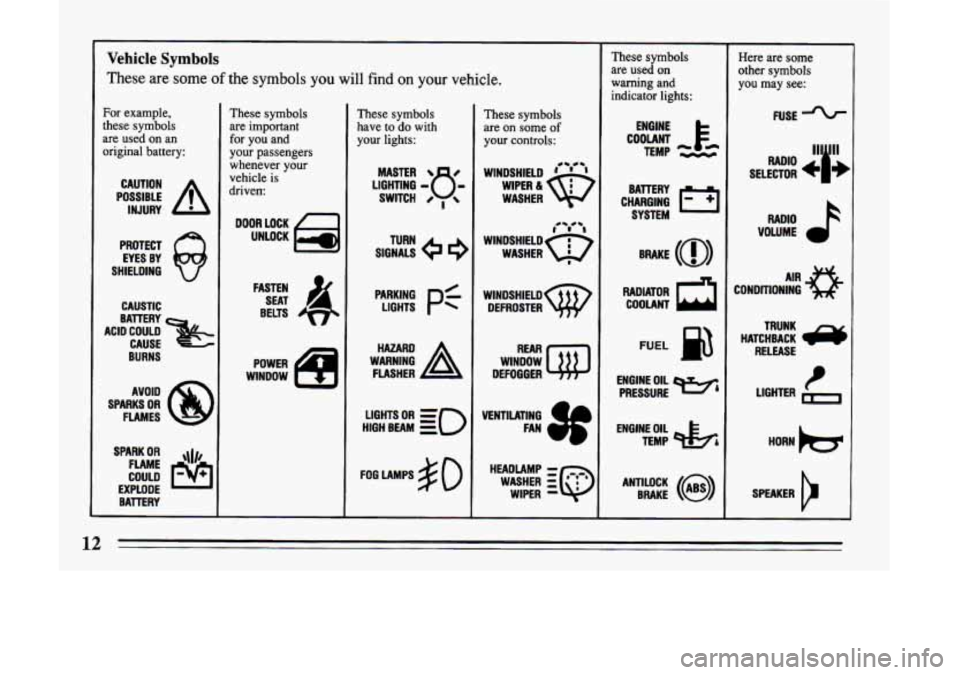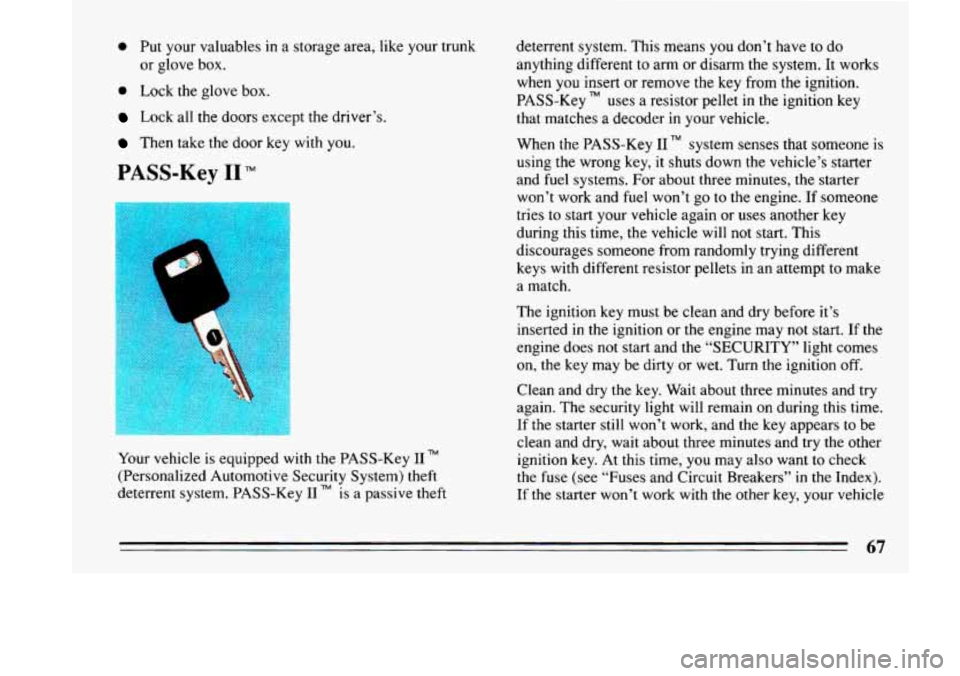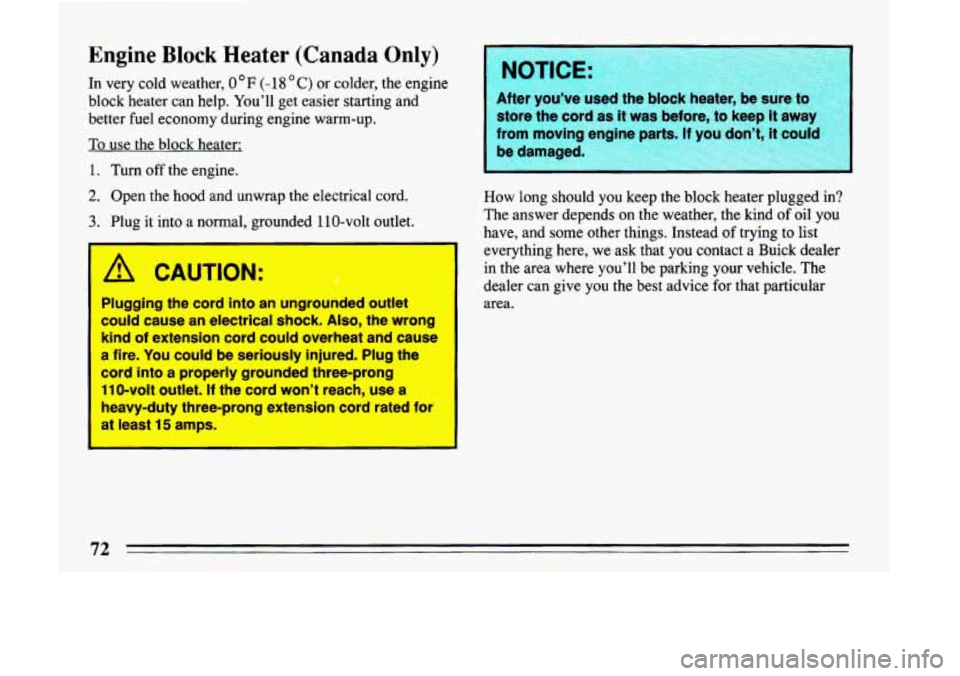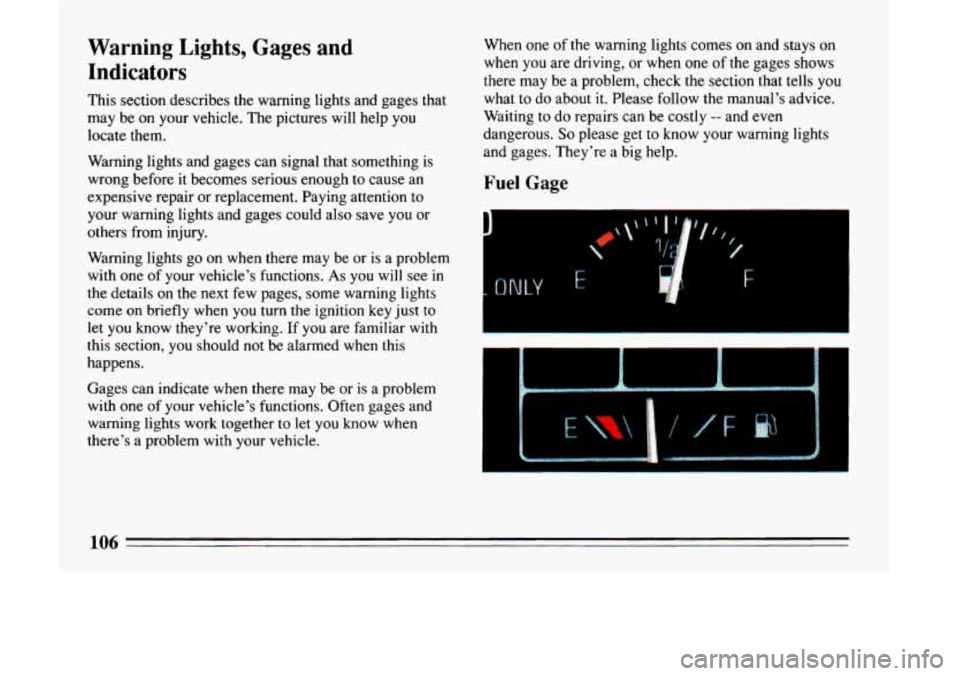1993 BUICK LESABRE fuel
[x] Cancel search: fuelPage 14 of 324

Vehicle Symbols
These
are some of the symbols you will find on your vehicle.
For example,
these symbols
are used on an
original battery:
POSSIBLE A
CAUTION
INJURY
PROTECT EYES BY
SHIELDING
Q
CAUSTIC
BURNS AVOID
SPARKS
OR
FLAMES
SPARK
OR ,\I/,
COULD FLAME
EXPLODE BATTERY
These symbols
are important
for you and
your passengers
whenever your
vehicle is
driven
DOOR LOCK
UNLOCK
FASTEN SEAT
4
BELTS
WINDOW POWER
These symbols
have
to do with
your lights:
LIGHTING - 8 -
MASTER 8
SWITCH 0 ,
SIGNALS e 9
TURN
LIGHTS
Pf
HIGH BEAM OR = =o
FOG LAMPS # 0
These symbols
are on some
of
your controls:
WINDSHIELD ' ' ' 4- e-
WASHER
wlNDsHIELDw DEFROSTER
WINDOW
DEFOGGER
HEADLAMP
- r~.c.r
WASHER :Q
WIPER -
These symbols
are used on
warning and
indicator lights:
COOLANT F*
TEMP -.--
ENGINE
CHARGING
I-1
BATTERY SYSTEM
RADIATOR
a
COOLANT
FUEL
ENGINE OIL
PRESSURE
TEMP OIL
&
ANTILOCK (@)
BRAKE
Here are some
other symbols
you
may see:
FUSE
RADIO >
VOLUME
CONDITIONING
AIR 33
HATCHBACK /y
TRUNK
RELEASE
t LIGHTER
Page 69 of 324

e Put your valuables in a storage area, like your trunk
0 Lock the glove box.
Lock all the doors except the driver’s.
Then take the door key with you.
or glove box.
PASS-Key I1 TM
Your vehicle is equipped with the PASS-Key I1 TM
(Personalized Automotive Security System) theft
deterrent system. PASS-Key I1
TM is a passive theft deterrent system.
This means you don’t have to do
anything different
to arm or disarm the system. It works
when you insert or remove the key from the ignition.
PASS-Key uses a resistor pellet in the ignition key
that matches
a decoder in your vehicle.
When the PASS-Key I1
TM system senses that someone is
using the wrong key, it
shuts down the vehicle’s starter
and fuel systems. For about three minutes, the starter
won’t work and
fuel won’t go to the engine. If someone
tries to start your vehicle again or uses another key
during this time, the vehicle will not start. This
discourages someone from randomly trying different
keys with different resistor pellets in an attempt to make
a match.
The ignition key must be clean and dry before it’s
inserted in the ignition or the engine may not start.
If the
engine does not start and the “SECURITY” light comes
on, the key may be dirty or wet. Turn the ignition off.
Clean and dry the key. Wait about three minutes and try
again. The security light will remain on during this time.
If the starter still won’t work, and the key appears to be
clean and dry, wait about three minutes and try the other
ignition key. At this time, you may also want to check
the
fuse (see “Fuses and Circuit Breakers” in the Index).
If the starter won’t work with the other key, your vehicle
67
Page 74 of 324

Engine Block Heater (Canada Only)
In very cold weather, 0 OF (- 18 C) or colder, the engine
block heater can help. You’ll get easier starting and
better fuel economy during engine warm-up.
To use the block heater:
1. Turn off the engine.
2. Open the hood and unwrap the electrical cord.
3. Plug it into a normal, grounded 110-volt outlet.
CAUTION: 0
Plugging the cord into an ungrounded outlet
could cause an electrical shock. Also, the wrong
kind
of extension cord could overheat and cause
a fire. You could be seriously injured. Plug the
cord into a properly grounded three-prong
110-volt outlet. If the cord won’t reach, use a
heavy-duty three-prong extension cord rated for
at least 15 amps. After you’ve
used the block heater, be sure to
store the
cord as it was before, to keep it away
from moving engine parts.
If you m’t, it could
be damaged
w1 ~
How long should you keep the block heater plugged in?
The answer depends on the weather,
the kind of oil you
have, and some other things. Instead
of trying to list
everything here,
we ask that you contact a Buick dealer
in the area where you’ll be parking your vehicle. The
dealer can give you the best advice for that particular
area.
Page 77 of 324

- Going about 35 mph (56 km/h) or more, push the
accelerator all the way down.
You’ll shift down to the next gear and have more
power.
0 D or 3 (Third Gear)
This is like
@, but you never go into Overdrive.
Here are some times you might choose
“D or 3”
instead of @:
- When driving on hilly, winding roads
- When towing a trailer, so there is less shifting
between gears
- When going down a steep hill
0 2 (Second Gear)
This position gives you more power but lower fuel
economy.
You can use “2” on hills. It can help
control your speed as you go down steep mountain
roads, but then you would also want to use your
brakes off and on.
NOTICE:
Don’t drive in “2” (S
or you can damage your trans
“D or 3” as much as possible.
e 1 (First Gear)
This position gives you even more power (but lower
fuel economy) than
“2.” You can use it on very steep
hills,
or in deep snow or mud. If the selector lever is
put in “1,” the transaxle won’t shift into first gear
until the vehicle is going slowly enough.
75
Page 106 of 324

Storage Armrest (Option) The Instrument Panel: Your
Information System
The armrest between the front seats opens into a storage
area.
To open it, press the lever at the front edge.
Inside a cupholder flips forward and unfolds to hold two
cups. The cupholder
is designed to breakaway should it
receive excessive pressure. If it breaks away, snap the
edges back into place.
There
is also a removeable coinholder, cassette tape and
compact disc storage area.
Your instrument panel is designed to let you know at a
glance
how your car is running. You'll know how fast
you're going, how much fuel you're using, and many
other things you'll need to know to drive safely and
economically.
104
Page 108 of 324

Warning Lights, Gages and
Indicators
This section describes the warning lights and gages that
may be on your vehicle. The pictures will help you
locate them.
Warning lights and gages can signal that something is
wrong before it becomes serious enough to cause an
expensive repair or replacement. Paying attention to
your warning lights and gages could also save
you or
others from injury.
Warning lights go on when there may be or
is a problem
with
one of your vehicle’s functions. As you will see in
the details
on the next few pages, some warning lights
come on briefly when
you turn the ignition key just to
let you know they’re working. If you are familiar with
this section, you should not be alarmed when this
happens.
Gages can indicate when there may be or is a problem
with one of your vehicle’s functions. Often gages and
warning lights work together to
let you how when
there’s a problem with your vehicle. When
one
of the warning lights comes on and stays on
when you are driving,
or when one of the gages shows
there may be
a problem, check the section that tells you
what to do about it. Please follow the manual’s advice.
Waiting to do repairs can be costly
-- and even
dangerous.
So please get to know your warning lights
and gages. They’re a big help.
Fuel Gage
r
F
”
I//,
0
ONLY E F F
106
Page 109 of 324

Your fuel gage shows about how much fuel is in your
tank. It works
only when the engine is on. When the
indicator nears
“E,” you still have a little fuel left. You
need to get more
fuel right away.
Here are four concerns some owners have had about the
fuel gage. All these situations are normal and indicate
nothing wrong with the
fuel gage.
0
0
0
0
At the gas station, the gas pump shuts off before the
gage reads
“F’.
It takes more (or less) gas to fill up than the gage
indicated. For example, the gage may have indicated
1/2
full, but it took more (or less) than half of the
tank’s capacity to fill it.
The gage moves a little when you turn a corner,
speed up, or stop your vehicle.
When
you turn the engine off, the gage doesn’t go all
the way back to “E”.
Low Fuel Light
If your Buick has this option, a yellow light near the fuel
gage, will
go on when your vehicle is low on fuel.
You should get more fuel as soon as you can.
Brake System Warning Light
Your Buick’s hydraulic brake system is divided into two
parts. If one part isn’t working, the other part can still
work and stop
you. For good braking, though, you need
both parts working well.
If the warning light goes on, there could be a brake
problem. Have your brake system inspected right away.
This light should come on as
you start the vehicle. If it
doesn’t come on then, have it fixed so it will be ready to
warn you if there’s a problem.
This light will also come on when you set your parking
brake, and the light will stay on
if your parking brake
doesn’t release
fully. If you try to drive off with the
107
Page 113 of 324

Engine Coolant Temperature Gage
If you have the Gage Cluster, you have a gage that
shows the engine coolant temperature. If the gage
pointer moves into the red area, your engine
is too hot!
That reading means the same thing as the warning light.
It means that
your engine coolant has overheated. If you
have been operating your vehicle under normal driving
conditions, you should pull off the road, stop your
vehicle and turn off
the engine as soon as possible.
HOT COOLANT CAN BURN YOU BADLY!
In “Problems on the Road,” this manual shows what to
do. See “Engine Overheating”
in the Index.
Malfunction Indicator Lamp
(Service Engine Soon Light)
SERVICE
,ENGINE SOON
SERVICE
ENGINE
SOON
A computer monitors operation of your fuel, ignition
and emission control systems. This light should come
on
when the ignition is on, but the engine is not running, as
a check to show
you it is working. If it does not come on
at all, have
it fixed right away. If it stays on, or it comes
on while you are driving, the computer
is indicating that
you have a problem. You should take your vehicIe in for
service soon.
111